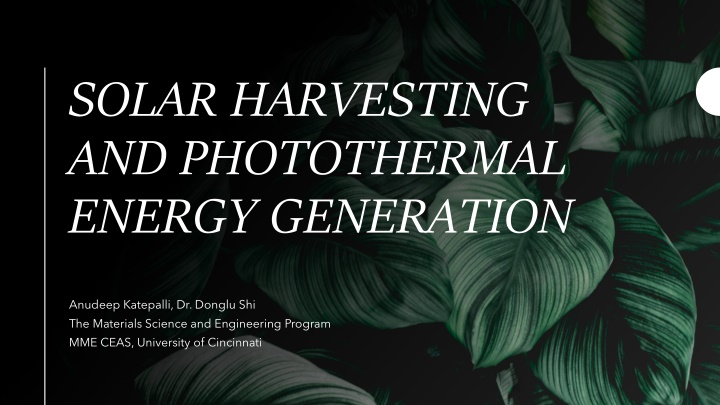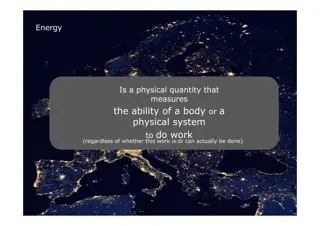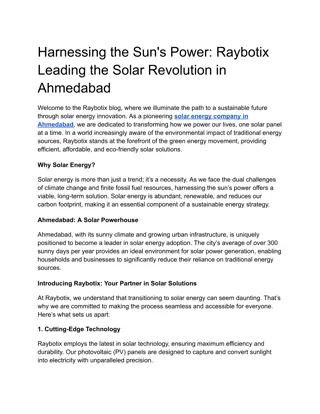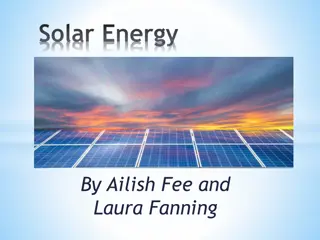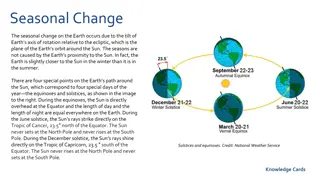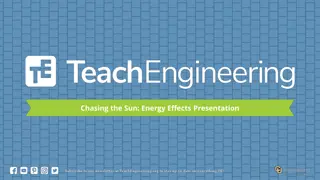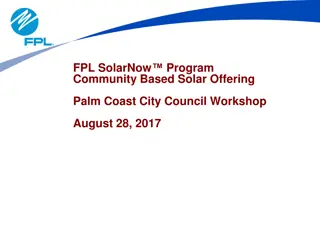Innovations in Solar Energy Harvesting and Photothermal Generation
Exploring the possibilities of 3D solar harvesting and spectral-selective nano hybrids for energy applications. Introduction of photothermal energy generation through transparent film multilayers. Delve into the advancements in PV solar cells and solar panels, paving the way for more efficient and impactful solar energy utilization. Unveil the key concepts such as short-circuit current (Isc), open-circuit voltage (Voc), maximum power point (Pmax), fill factor, power conversion efficiency (PCE), and light intensity in the solar energy domain.
Download Presentation

Please find below an Image/Link to download the presentation.
The content on the website is provided AS IS for your information and personal use only. It may not be sold, licensed, or shared on other websites without obtaining consent from the author.If you encounter any issues during the download, it is possible that the publisher has removed the file from their server.
You are allowed to download the files provided on this website for personal or commercial use, subject to the condition that they are used lawfully. All files are the property of their respective owners.
The content on the website is provided AS IS for your information and personal use only. It may not be sold, licensed, or shared on other websites without obtaining consent from the author.
E N D
Presentation Transcript
SOLAR HARVESTING AND PHOTOTHERMAL ENERGY GENERATION Anudeep Katepalli, Dr. Donglu Shi The Materials Science and Engineering Program MME CEAS, University of Cincinnati
OUTLINE Possibility of 3D solar harvesting Spectral selective nano hybrids in energy applications Photothermal energy generation via multilayers of transparent films
1. PV Solar Cells: The Energy Sponges That Sunbathe All Day: These PV solar cells are like the beach bums of the energy universe, catching rays and converting them into electrical energy . Shining a Light on Solar Innovation: The Rise of 3D Solar Harvesting 2. Solar Panels: As Two-Dimensional as Your Ex's Texts: These panels used to be flatter than a romance novel's plotline, but now we're spicing things up with a third dimension! 3. Enter the Third Dimension: We decided, "Let's give these panels some depth!" We went all 'Inception' on solar harvesting, introducing the z-axis. 4. Solar Panel Skyscrapers: It's like having a solar cityscape! CdTe solar panels stacked like Jenga blocks, reaching for the sun like it owes them money. 5. Solar Sleight of Hand: These panels are so transparent; they could make a magician's disappearing act look like child's play! 6. Multiply the Fun: Now, sunlight can play hide and seek through multiple panels, making it feel like a game of cosmic pinball. 7. Total Eclipse of the Sun: When it comes to output power, these multi-panel setups are like the Beyonc of solar energy - they run the world. 8. Urban Space Whisperers: In crowded cities, these panels are like the architects of sunlight, making every square inch count without causing solar gridlock. 9. Solar Superheroes: So, there you have it, our solar heroes - saving the planet one photon at a time and making science look cool while doing it.
1.Isc (Short-Circuit Current): This is the "Oops, I tripped" current. It's like when you're carrying too many snacks from the kitchen, and you accidentally hit the light switch, causing a sudden surge of current. Solar Terms Made Simple: Fun and Light Insights into Photovoltaics 2.Voc (Open-Circuit Voltage): Voc is the "Knock, Knock, Anyone Home?" voltage. It's the potential difference between two ends of a solar panel when no current is flowing, like a doorbell ringing in an empty house. 3.Pmax (Maximum Power Point): Pmax is the "Goldilocks Zone" of solar power. It's the sweet spot where your solar panel is working at its peak, not too hot, not too cold, but just right! 4.Fill Factor: Think of this as the "Space Efficiency" factor. It's like Tetris for solar cells, making sure they fit together perfectly and don't leave any awkward gaps. 5.PCE (Power Conversion Efficiency): PCE is the "Magic Wand" of solar panels. It's the percentage of sunlight that your panel turns into electricity the higher, the better. Like turning sunlight into gold! 6.Light Intensity: Light intensity is the "Sunshine Strength Meter." It measures how much oomph the sun's rays are packing. It's like checking if your solar panel is getting a gentle pat on the back or a full- on high-five from the sun.
Experimental Details 1. Solar Panel Selection: We used five commercial CdTe solar panels from Solar First Technology Co., each with dimensions of 150 150 mm . These panels had different average visible transmittance (AVT) values: 80%, 70%, 60%, 50%, and 40%. 2. Measurement Setup: We connected a SourceMeter instrument to these panels as the Device Under Test (DUT). The instrument operated in voltage source mode, allowing us to sweep voltage from 0 V to 20 V. At each voltage step (400 in total), the SourceMeter recorded the current flowing through the panels. 3. Data Analysis: We utilized the collected dataset to compute key parameters such as Voc (Open-Circuit Voltage), Isc (Short-Circuit Current), Pmax (Maximum Power), F.F (Fill Factor), and PCE (Photon Conversion Efficiency). Only data points between Isc and Voc were considered for analysis. Absolute values of the current data within this range were used for plotting.
Single Layer Power Output Solar Panel AVT ???(?) F.F P.C.E Light Power Density ??? (?) ???? (?) (mW/???) 40% 12.732 0.141 1.072 0.594 8.60% 55.4 50% 12.130 0.119 0.723 0.500 5.80% 55.4 60% 12.732 0.095 0.553 0.456 4.44% 55.4 70% 12.431 0.070 0.466 0.534 3.74% 55.4 80% 11.378 0.048 0.242 0.443 1.94% 55.4
MULTI LAYER POWER OUTPUT FROM 80%AVT- 40%AVT Solar Panel ???(?) F.F P.C.E Light Power Density ??? (?) ???? (?) AVT (mW/???) 80% 10.977 0.047 0.235 0.452 1.89% 55.400 70% 10.928 0.048 0.302 0.880 3.02% 44.320 60% 10.927 0.019 0.110 0.511 1.57% 31.024 50% 9.223 0.019 0.090 0.508 2.16% 18.614 40% 9.624 0.007 0.047 0.664 2.24% 9.307 NET POWER OUTPUT: 0.786 WATTS
MULTI LAYER POWER OUTPUT FROM 40%AVT- 80%AVT Light Power Density Solar Panel AVT ??? (?) ???? (?) ???(?) F.F P.C.E (mW/???) 40% 11.880 0.174 1.197 0.576 9.60% 55.400 50% 10.075 0.030 0.162 0.522 3.25% 22.160 60% 9.624 0.008 0.046 0.557 1.87% 11.080 70% 8.922 0.005 0.022 0.505 1.52% 6.648 80% 7.319 0.002 0.011 0.538 1.05% 4.653 NET POWER OUTPUT : 1.44 WATTS
Ascending Order Scenario: SOLAR PANEL SOLAR PANEL PCE PCE 1.Opaque Champion: In the ascending order, the top 40% transparent panel shines like a star with a PCE of 9.60%. AVT ASCENDING AVT DESCENDING 2.Diminished Radiance: However, as you move down the transparency ladder, the PCEs of the other panels take a nosedive due to reduced light power densities. 1ST 40% 9.60% 1ST 80% 1.89% 3.Teamwork Triumphs: When we calculate the PCE of the entire system with all five solar panels stacked together, it yields an impressive PCE of 11.53%. That's a 20% increase compared to the best solo performer! 2ND 50% 3.25% 2ND 70% 3.02% 3RD 60% 1.87% 3RD 60% 1.57% 4TH 70% 1.52% 4TH 50% 2.16% Descending Order Scenario: 5TH 80% 1.05% 5TH 40% 2.24% 4.High Transparency Leader: In the descending order, the top 80% transparent panel starts with a modest PCE of 1.89%. NET PCE 11.53% 6.3% 5.Rise of the Layers: But here's where it gets interesting - when all five solar panels join forces, the PCE of the entire system reaches 6.3%. That's a 233% increase, thanks to the power of multiple layers stacking up!
Photothermal Materials: Shining Light on Photothermal and Plasmonic Materials Heat-Generating Wizards: Photothermal materials are like wizards of heat. When exposed to light, they can absorb it and then convert it into heat. It's like turning sunshine into a cozy blanket of warmth. Applications Galore: These materials are incredibly versatile. They find applications in solar energy harvesting, photothermal therapy (for treating diseases like cancer), and even in creating invisible ink that appears when heated by light. Plasmonic Materials: Metallic Marvels: Plasmonic materials are usually made of metals like gold, silver, iron and copper. These metals have a unique property - they can interact with light in a fascinating way. Light Benders: When light hits plasmonic materials, their electrons start dancing to a special tune. This dance, known as surface plasmon resonance, can bend light in peculiar and useful ways. Tiny Optical Tools: Plasmonic materials can be engineered into tiny structures called nanoparticles. These nanoparticles act like superheroes of optics, enabling super-resolution imaging, enhanced light absorption in solar cells, and even making colors in stained glass windows more vibrant.
Porphyrins: Energy Generation in the Spotlight: Porphyrins vs. Plasmonic Materials Nature's Colour Palette: Porphyrins are like the artists of the natural world. They're organic compounds found in various living organisms, including plants and animals. Their most famous member is chlorophyll, which gives plants their green colour and plays a crucial role in photosynthesis. Heat Production: Porphyrins, when exposed to light, can absorb photons and generate heat. This property is especially important in photosynthesis, where they capture sunlight and convert it into chemical energy. Biological Marvels: Porphyrins are vital in living organisms, serving as the core structure in heme (found in hemoglobin and myoglobin) and chlorophyll (crucial for photosynthesis). They play essential roles in oxygen transport and energy production. Comparison with Plasmonic Materials: Heat Generation Mechanism: Porphyrins generate heat through a process known as non- radiative decay. When they absorb light, the energy is dissipated as heat. Plasmonic materials, on the other hand, generate heat through a different mechanism called surface plasmon resonance (SPR). In SPR, metallic nanoparticles interact with light, and the energy is converted into localized heat due to electron oscillations. Materials: Porphyrins are organic molecules typically found in biological systems. Plasmonic materials are typically metallic, such as gold or silver nanoparticles. Applications: Porphyrins have applications in biology and medicine, such as photodynamic therapy for cancer treatment and as a photosensitizer in solar cells. Plasmonic materials find applications in areas like plasmonic photothermal therapy (PPTT), where they are used to selectively heat and destroy cancer cells. Wavelength Range: Porphyrins generally absorb light in the visible and near-infrared spectrum. Plasmonic materials can be engineered to absorb light at specific wavelengths, making them versatile for various applications.
Dye-sensitized solar cells (DSSCs) Dye-Sensitized Solar Cells (DSSCs): DSSCs are a type of solar cell that mimic photosynthesis by using a photosensitive dye to capture sunlight and convert it into electricity. Absorption of Light: Porphyrins efficiently absorb light, and when they absorb a photon, they become electronically excited. Non-Radiative Decay: As you mentioned, some of the energy from this excitation may be lost through non-radiative decay processes, such as internal vibrations or heat dissipation. Electron Injection: Despite the non-radiative decay, the excited porphyrin molecule still has excess energy. In a solar cell, this excess energy can be used to overcome the energy barrier required to inject an electron into a nearby semiconductor material (e.g., titanium dioxide) through a process called photoinduced electron injection. (a) DSSC structure and (b) Schematic working principle of DSSC. Electron Transport: The injected electron can then move through the semiconductor material, creating an electric current. The energy loss from non-radiative decay does not prevent the injection of the electron into the semiconductor Jou Lin and Donglu Shi, Applied Physics Reviews 8, 011302 (2021)
Photothermal Generator (PTG) Vertically Stacked Thin Films: Photothermal generators are composed of multiple thin films stacked vertically on top of each other. These films are designed to efficiently capture and convert light energy into heat. Applications: These generators find applications in solar energy harvesting, water purification, and even in medical devices like hyperthermia treatments for cancer therapy. Compact and Scalable: Photothermal generators are often compact and scalable, making them suitable for a wide range of applications, from portable devices to large-scale energy systems. Sustainability: They offer a sustainable energy solution by utilizing sunlight or other light sources, making them environmentally friendly and reducing the reliance on fossil fuels.
Heating Curves Heating Curves Infrared thermal photographs of the photo-thermal generator with 10 layers of Fe3O4@Cu2-xS films (85% AVT) illuminated by solar simulator (0.4 W cm-2 power density) for different times.
Conclusion 1.3D Solar Panel Innovations: 1. Traditional 2D PV solar panels have limitations in surface area, requiring large spaces for efficient energy conversion. 2. Innovative 3D solar panel designs, like stacking multiple CdTe solar panels, significantly increase solar harvesting surface area. 3. Advantages include higher energy density, increased total output power, and reduced surface area requirements, making them ideal for densely populated urban areas. 2.Porphyrins in DSSCs: 1. Porphyrins are essential components in Dye-Sensitized Solar Cells (DSSCs), where they serve as photosensitive dyes. 2. They efficiently absorb light and release electrons, contributing to electricity generation. 3.Porphyrins in Photothermal Generators: 1. Porphyrins can also be used in photothermal generators, where they efficiently convert light into heat for various applications. 4.Plasmonic Materials in Photothermal Generators: 1. Plasmonic materials, such as metallic nanoparticles, are utilized in photothermal generators to create localized heat through surface plasmon resonance (SPR).
